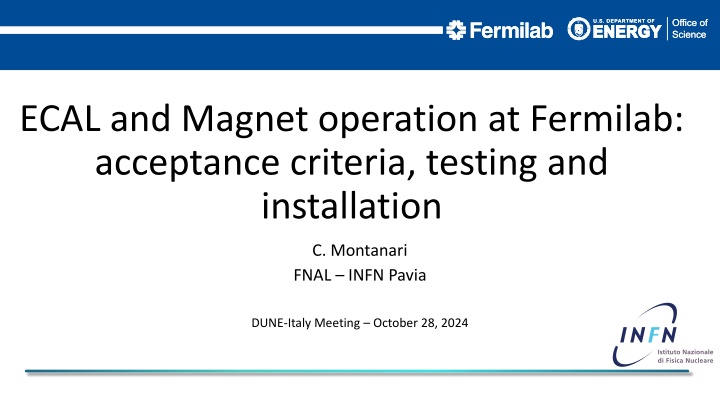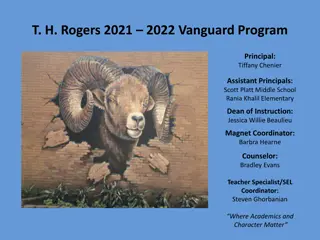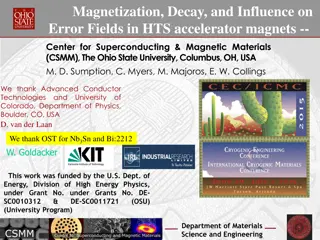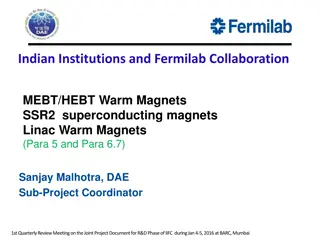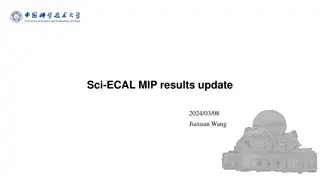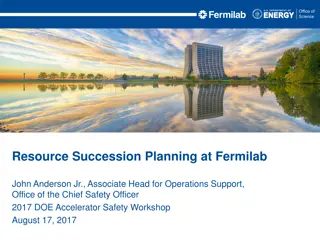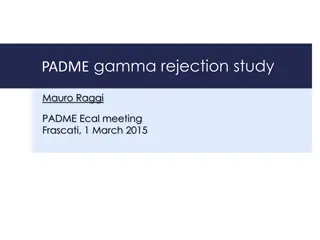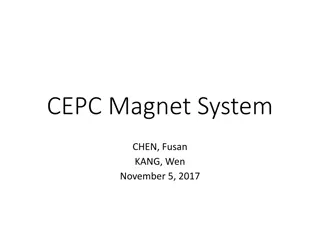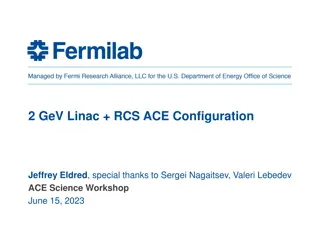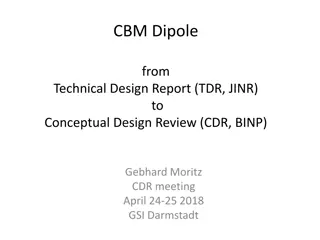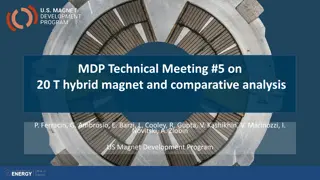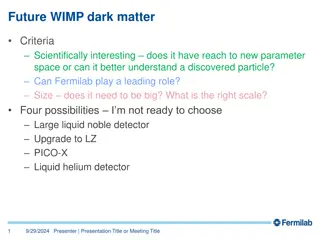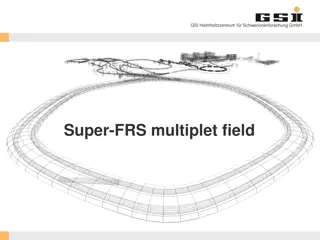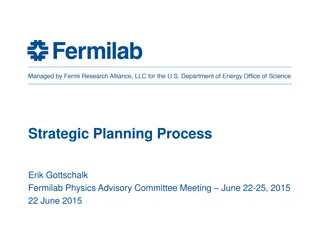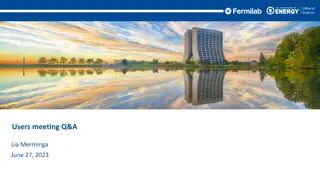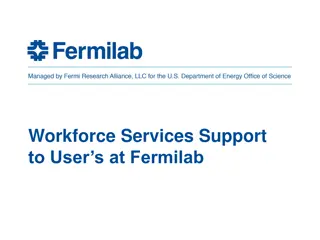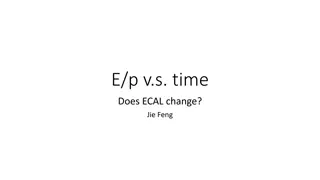ECAL and Magnet Operation at Fermilab Acceptance Criteria
Equipment brought to Fermilab for installation must meet safety requirements outlined in the Fermilab Environment, Safety and Health Manual (FESHM). Design requirements are based on ASME codes with additional restrictions for environmental conditions. Operational Readiness Reviews and Written Work Plans are essential for verifying safety compliance. Electrical Engineering Requirements involve retrofitting power distribution to North American standards and following FESHM guidelines for equipment approval and customization. Adequate documentation is necessary to demonstrate safe design, installation, operation, and dismantling.
Download Presentation

Please find below an Image/Link to download the presentation.
The content on the website is provided AS IS for your information and personal use only. It may not be sold, licensed, or shared on other websites without obtaining consent from the author.If you encounter any issues during the download, it is possible that the publisher has removed the file from their server.
You are allowed to download the files provided on this website for personal or commercial use, subject to the condition that they are used lawfully. All files are the property of their respective owners.
The content on the website is provided AS IS for your information and personal use only. It may not be sold, licensed, or shared on other websites without obtaining consent from the author.
E N D
Presentation Transcript
ECAL and Magnet operation at Fermilab: acceptance criteria, testing and installation C. Montanari FNAL INFN Pavia DUNE-Italy Meeting October 28, 2024
Generalities Equipment being brought at Fermilab for installation and operation has to fulfill a set of minimal requirements related to safety. Specific requirements, as well as design, assembly and testing protocols, are detailed in several chapters of Fermilab Environment, Safety and Health Manual (FESHM - https://eshq.fnal.gov/manuals/feshm/). FESHM is a DOE approved document. Design requirements are based on the relevant ASME codes, although, in some cases, additional restrictions apply, due to specific environmental conditions. Equipment has to be provided with appropriate documentation to allow Fermilab review panels to verify conformity to safety requirements. Operational Readiness Reviews are processes that include review of documentation, testing of subcomponents and walkthroughs of installations, that have to take place before Clearance for operation can be granted. Written Work Plans, detailing installation or testing procedures, are routinely used to identify hazards and appropriate mitigation procedures. SAND-US group is formed to assist SAND Consortium in assembling, testing and operating the DUNE-SAND detector at Fermilab. 2 C. Montanari | ECAL and Magnet Operation ... | DUNE-Italy Meeting - Oct 28, 2024
Electrical Engineering Requirements (T. Shaw & L. Bagby) With the move of the detector to the Fermilab site, all power distribution must be retrofitted to follow North American standards - the National Electrical Code (NEC), or NFPA 70E. In addition, Fermilab provides several chapters in the Fermilab Environment, Safety and Health Manual (FESHM) which are relevant. All commercial powered equipment should pass a US nationally recognized testing laboratory (NRTL) and be installed and used in accordance with the listing. International code equivalencies or codes with reduced inspection requirements are listed in the technical appendix of FESHM 9110: Electrical Utilization Equipment Safety. For all unlisted or non-NRTL electrical equipment, FESHM 9111: Approval of Unlisted Electrical Equipment provides the steps required for the evaluation and approval by the Electrical Authority Having Jurisdiction (AHJ). Custom electronics will be reviewed according to the FESHM 9000 Electrical Safety chapters, Fermilab s Electrical Design Standards for Electronics in Experimental Apparatus, and Fermilab s Electrical Safety ORC Review Guidelines. Custom electronics are defined as any powered equipment which is not commercially available and includes all printed circuit boards, chassis which contain a collection of commercial/custom electronics with internal wiring completed by the user, any commercial equipment with a modification and any equipment which does not have a NRTL seal. Where an NRTL approved version of an item of equipment does not exist the procedure set out in FESHM 9111 shall be applied. For each electrical system (or subsystem), a documentation set should be produced which contains the required list of documents that will demonstrate that the equipment has been designed and assembled respecting safety principles and that it can be installed, commissioned, operated and then dismantled safely. 3 C. Montanari | ECAL and Magnet Operation ... | DUNE-Italy Meeting - Oct 28, 2024
Documentation required for electrical equipment (T. Shaw & L. Bagby) Objective of analysis and scope of equipment to be analyzed. References to design codes or standards that are utilized in the analysis. Personnel and qualifications carrying out the analysis. A system (or subsystem) level block diagram showing the entire planned installation, including both commercial and custom components. This must include any wire/cable connections with detailed information on wire/cable sizes (AWG or mm2), lengths and connectors. This is especially vital for all power paths. Analysis showing all system level power paths provide appropriately sized fuses, wire/cable and connectors. Complete schematics of any custom printed circuit boards with layout files and a detailed analysis of any power paths or power planes used. Use of fuses must be documented. If fuses are not used, a note on why they are not required must be provided. Identification of any high voltage paths. (Hazardous Electrical Energy levels which will require additional documentation are identified in FESHM 9100 section 6.1). Adherence to electric and mechanical tolerances on all connections. Information on all commercial equipment, including NRTL or equivalent rating. These documents shall cover the operational lifetime of the concerned equipment or detector. The versioning of these documents should be maintained and controlled on EDMS. The documentation provided must contain sufficient detail so that results are reproducible and peer-reviewable 4 C. Montanari | ECAL and Magnet Operation ... | DUNE-Italy Meeting - Oct 28, 2024
Reference Documents: Electricals Document ID Number/URL https://esh-docdb.fnal.gov/cgi-bin/sso/ShowDocument?docid=7141 Document Title FESHM 1071: Codes & Standards https://esh-docdb.fnal.gov/cgi-bin/sso/ShowDocument?docid=3253 FESHM 2110: Ensuring Equivalent Safety Performance when Using International Codes and Standards FESHM 9100: Fermilab Electrical Safety Program (Work Smarts Standard) FESHM 9110: Electrical Utilization Equipment Safety (Work Smart Standard) FESHM 9111: APPROVAL OF UNLISTED ELECTRICAL 6 EQUIPMENT FESHM 9120: AC Electrical Power Distribution Safety (Work Smarts Standard) FESHM 9130: Management and Use of Cable Tray Systems (Work Smarts Standard) FESHM 9140: Protection Against Exposed Electrical Bus (Work Smart Standard) http://esh-docdb.fnal.gov/cgi-bin/ShowDocument?docid=375 http://esh-docdb.fnal.gov/cgi-bin/ShowDocument?docid=521 https://esh-docdb.fnal.gov/cgi-bin/sso/ShowDocument?docid=7567 http://esh-docdb.fnal.gov/cgi-bin/ShowDocument?docid=376 http://esh-docdb.fnal.gov/cgi-bin/ShowDocument?docid=377 http://esh-docdb.fnal.gov/cgi-bin/ShowDocument?docid=541 5 C. Montanari | ECAL and Magnet Operation ... | DUNE-Italy Meeting - Oct 28, 2024
Reference Documents: Electricals (cont.) Document ID Number/URL http://esh-docdb.fnal.gov/cgi-bin/ShowDocument?docid=378 http://esh-docdb.fnal.gov/cgi-bin/ShowDocument?docid=379 Document Title FESHM 9150: High Voltage Coaxial Connectors FESHM 9160: Low Voltage, High Current Power Distribution Systems (Work Smarts Standard) FESHM 9170: Uninterruptible Alternating Current Power Back-Up Systems FESHM 9180: Hazard Mitigation for Electrical Workers (Work Smart Standard) FESHM 9190: Grounding Requirements for Electrical Distribution and Utilization Equipment FESHM 2005: Operational Readiness Clearance FESHM 2110: Fermilab Energy Control Program (Lockout/Tagout) Electrical Design Standards for Electronics in Experimental Apparatus Electrical Safety ORC Review Guidelines Fire/Life Safety ORC Review Guidelines for Experimental Installations Operational Readiness Clearance (ORC) Guidelines Fermilab Engineering Manual http://esh-docdb.fnal.gov/cgi-bin/ShowDocument?docid=522 http://esh-docdb.fnal.gov/cgi-bin/ShowDocument?docid=380 http://esh-docdb.fnal.gov/cgi-bin/ShowDocument?docid=2815 http://esh-docdb.fnal.gov/cgi-bin/ShowDocument?docid=3311 http://esh-docdb.fnal.gov/cgi-bin/ShowDocument?docid=393 http://esh-docdb.fnal.gov/cgi-bin/ShowDocument?docid=2781 http://esh-docdb.fnal.gov/cgi-bin/ShowDocument?docid=3270 http://esh-docdb.fnal.gov/cgi-bin/ShowDocument?docid=3270 http://esh-docdb.fnal.gov/cgi-bin/ShowDocument?docid=3270 http://directorate-docdb.fnal.gov/cgi-bin/RetrieveFile?docid=34 6 C. Montanari | ECAL and Magnet Operation ... | DUNE-Italy Meeting - Oct 28, 2024
Mechanical and Cryogenics Engineering Requirements (M.J. Kim) For any system and component received at Fermilab and its leased spaces (at its remote sites) to be qualified for operations, a set of proper documentation proving the compliance with the applicable codes and standards shall be provided. To understand the requirements and types of documents necessary for each system or component to prove conformity, various chapters of Fermilab Environment, Safety and Health Manual (FESHM) must be reviewed and adequately followed at best effort. FESHM 1071 describes all applicable codes and standards for mechanical, cryogenics, electrical, fire protection, and pressure systems, required when designing, fabricating, testing, and operating a new one, evaluating the features and processes, and the assembly of the facility. Document ID Number/URL https://esh-docdb.fnal.gov/cgi-bin/sso/ShowDocument?docid=7141 https://esh-docdb.fnal.gov/cgi-bin/sso/ShowDocument?docid=3253 Document Title FESHM 1071: Codes & Standards FESHM 2110: Ensuring Equivalent Safety Performance when Using International Codes and Standards FESHM 5031: Pressure Vessels http://esh-docdb.fnal.gov/cgi-bin/ShowDocument?docid=456 FESHM 5031.1: Piping Systems http://esh-docdb.fnal.gov/cgi-bin/ShowDocument?docid=362 FESHM 5031.5: Low Pressure Vessels and Fluid Containment http://esh-docdb.fnal.gov/cgi-bin/ShowDocument?docid=366 FESHM 5032: Cryogenic System Review FESHM 5032.1: Cryogenic Dewar Installation and Operation Rules FESHM 5033: Vacuum Vessel Safety FESHM 5100: Structural Safety http://esh-docdb.fnal.gov/cgi-bin/ShowDocument?docid=528 http://esh-docdb.fnal.gov/cgi-bin/ShowDocument?docid=367 http://esh-docdb.fnal.gov/cgi-bin/ShowDocument?docid=371 http://esh-docdb.fnal.gov/cgi-bin/ShowDocument?docid=4112 7 C. Montanari | ECAL and Magnet Operation ... | DUNE-Italy Meeting - Oct 28, 2024
Reference Documents: Mechanics and Cryogenics Document ID Number/URL http://esh-docdb.fnal.gov/cgi-bin/ShowDocument?docid=356 Document Title FESHM 10100: Overhead Cranes and Hoists http://esh-docdb.fnal.gov/cgi-bin/ShowDocument?docid=357 FESHM 10110: Below-the-Hook Lifting Devices http://esh-docdb.fnal.gov/cgi-bin/ShowDocument?docid=358 FESHM 10120: Powered Industrial Trucks http://esh-docdb.fnal.gov/cgi-bin/ShowDocument?docid=360 FESHM 10130: Slings and Rigging Hardware http://esh-docdb.fnal.gov/cgi-bin/ShowDocument?docid=5540 FESHM 10200: Lift Plans http://esh-docdb.fnal.gov/cgi-bin/ShowDocument?docid=6970 FESHM 10210: Equipment Transport http://esh-docdb.fnal.gov/cgi-bin/ShowDocument?docid=3311 FESHM 2005: Operational Readiness Clearance http://esh-docdb.fnal.gov/cgi-bin/ShowDocument?docid=525 FESHM 2060: Work Planning and Hazard Analysis 8 C. Montanari | ECAL and Magnet Operation ... | DUNE-Italy Meeting - Oct 28, 2024
Pressure vessels and piping Current EU directive: 2014/68/UE PED mandatory in Italy from February 15, 2016. Previous EU directive: 97/23/CE mandatory in Italy from February 25, 2000. Applies to equipment operating at relative pressure > 0.5 bar (design pressure). A DOE variance recognizes the substantial equivalence between the European Pressure Equipment Directive and the American ASME codes for the same equipment and allows use of EU certified equipment. This variance can only be applied to in kind contributions to DUNE. The variance applies to some of SAND s components: GRAIN cryogenic system, tracker gas system, magnet external helium system and, in general, to all newly build components involving pressurized gases. The variance does not apply to KLOE s magnet as it was built prior to the first EU Directive. Fermilab has a general need to accept legacy/existing/reused/relocated pressure equipment, which needs to be transferred to Fermilab from collaborating institutions and operated at Fermilab site. Such legacy/existing/reused/relocated equipment could be originally designed and constructed per ASME or International codes listed in 10CFR851 and its recent Variance, or, in infrequent occasions, it could lack any established code pedigree. Specifically, there is a need to evaluate the cryogenic pressure components of the KLOE superconducting magnet, which include small helium vessel located inside the magnet's turret and cryogenic piping, for which no code pedigree could be established. 9 C. Montanari | ECAL and Magnet Operation ... | DUNE-Italy Meeting - Oct 28, 2024
Fermilab Approval Process for KLOE Magnet Fermilab realizes that there is a difference between the set of rules applied for the newly constructed pressure equipment versus the set of the general post-construction rules applied for legacy/existing/reused/relocated pressure equipment, e.g. KLOE Helium System slated for transfer from INFN to Fermilab. The ASME/API procedures governing Fitness for Service (FFS) described in API-579 provide a methodology for the evaluation of pressure safety for existing post-constructed equipment. To remediate this situation, Fermilab started on two initiatives: Development of a new Fermilab ESH Manual chapter 5036, which would describe application of FFS to the legacy/existing/reused/relocated pressure equipment at Fermilab, including equipment without any established code pedigree, e.g. KLOE. Working with an outside consultant, Mr. George Antaki, who is internationally recognized for his expertise in ASME/API FFS methodology, to evaluate safety of KLOE pressure equipment, including: assessment of risks and consequences of failures; assessment of inspections and tests; application of FFS methodology for interpretation of records,, inspections, tests, etc.; proposing replacements, repairs, enhancements needed to mitigate identified risks. As of Oct 2024, Mr. Antaki submitted a 48,000 USD proposal in three phases. 10 C. Montanari | ECAL and Magnet Operation ... | DUNE-Italy Meeting - Oct 28, 2024
Fitness For Service Proposed Process Phase 1: Pedigree Assessment Determine the pedigree of the existing helium vessel and piping of the INFN KLOE magnet, compared to the construction rules of ASME VIII and ASME B31.3, which covers the following construction areas for the pressure boundary: 1. Materials 2. Code design 3. Fabrication 4. Examination 5. Testing Fermilab and Mr. Antaki will have to work with INFN to review all available information for KLOE pressure equipment. Phase 2: Compliance Actions If Phase 1 identifies shortcomings in the construction records of the pressure boundary of the existing helium vessel and piping of the INFN KLOE magnet, actions will be proposed to achieve an equivalent level of safety as the ASME Codes. 11 C. Montanari | ECAL and Magnet Operation ... | DUNE-Italy Meeting - Oct 28, 2024
Fitness For Service Proposed Process (cont.) Phase 3: Fitness-for-Service Guidance will be developed to achieve fitness-for-service (i.e., continued safe and reliable operation) of the pressure boundary of the helium vessel and piping of the INFN KLOE magnet, in the form of: 1. Proposed periodic inspections and tests. 2. Fitness-for-service acceptance criteria of the results of the inspections and tests. 3. Options for repairs or alterations if necessary. A contract is being prepared, covering the first two phases with deliverables, in the form of documents, for each phase. Fermilab engineering is involved in the development and approval of the various steps, in particular the conclusions of Phase 2. Testing of the magnet in Frascati and its replica at Fermilab will be fundamental milestones in the process. 12 C. Montanari | ECAL and Magnet Operation ... | DUNE-Italy Meeting - Oct 28, 2024
Milestones (in reverse order) Magnet + ECAL + YOKE + internal support structure assembly in the cavern complete and ready to move in the alcove: March 2029 Start installation in the cavern: October 2028 Magnet delivered at Fermilab: March 2027 ECAL delivered at Fermilab: June 2027 Magnet tested in Frascati: July 2026 ECAL refurbished and tested in Frascati: November 2026 13 C. Montanari | ECAL and Magnet Operation ... | DUNE-Italy Meeting - Oct 28, 2024
Proposed timeline for SAND construction and delivery (I) Project 7/7/24 created with QuickPlan for macOS 2021 Q2 Q3 Q4 Q1 Q2 Q3 Q4 Q1 Q2 Q3 Q4 Q1 Q2 Q3 Q4 Q1 Q2 Q3 Q4 Q1 Q2 Q3 Q4 Q1 Q2 Q3 Q4 Q1 Q2 Q3 Q4 Q1 Q2 Q3 Q4 Q1 Q2 Q3 Q4 Q1 Q2 2022 2023 2024 2025 2026 2027 2028 2029 2030 2031 ND Site Available Testing Area Available Beam Checkout DOE - CD-2 for ND (ESAAB) TBD DOE - CD-3 for ND (ESAAB) TBD Definition of the final detector configuration Fund raising Detector Integrated engineering design Infrastructure integrated design KLOE Disassembly in Italy Magnet, Yoke Inspection and re-certification 14 C. Montanari | ECAL and Magnet Operation ... | DUNE-Italy Meeting - Oct 28, 2024
Proposed timeline for SAND construction and delivery(II) 2021 Q2 Q3 Q4 Q1 Q2 Q3 Q4 Q1 Q2 Q3 Q4 Q1 Q2 Q3 Q4 Q1 Q2 Q3 Q4 Q1 Q2 Q3 Q4 Q1 Q2 Q3 Q4 Q1 Q2 Q3 Q4 Q1 Q2 Q3 Q4 Q1 Q2 Q3 Q4 Q1 Q2 2022 2023 2024 2025 2026 2027 2028 2029 2030 2031 Procurement of new parts (PW supply, Mechanical, ...) Modification of mezzanine platforms Magnet test in Frascati Yoke disassembly and magnet extraction Packaging Transport to FNAL Magnet QA/QC and cold test at Fermilab ECAL Construction of tooling for assembly/diassembly Disassembly and inspection Glueing and re-wrapping of ECAL modules Modules test Selection and test of readout electronics Procurement of HV system Procurement of readout electronics 15 C. Montanari | ECAL and Magnet Operation ... | DUNE-Italy Meeting - Oct 28, 2024
Proposed timeline for SAND construction and delivery (III) 2021 Q2 Q3 Q4 Q1 Q2 Q3 Q4 Q1 Q2 Q3 Q4 Q1 Q2 Q3 Q4 Q1 Q2 Q3 Q4 Q1 Q2 Q3 Q4 Q1 Q2 Q3 Q4 Q1 Q2 Q3 Q4 Q1 Q2 Q3 Q4 Q1 Q2 Q3 Q4 Q1 Q2 2022 2023 2024 2025 2026 2027 2028 2029 2030 2031 Packaging Delivery to FNAL ECAL modules post-delivery QA/QC Inner tracker modules construction GRAIN Subdetector construction and test Engineering design Prototyping Materials procurement Cryogenic Components Electronics and sensors Detector components assembly and integration Preparation of the test facility Legnaro INFN Lab Complete detector test in Legnaro (with temperary outer vessel) Packging and delivery to Fermilab QA/QC test at Fermilab 16 C. Montanari | ECAL and Magnet Operation ... | DUNE-Italy Meeting - Oct 28, 2024
Proposed timeline for SAND Installation (I) ND Hall available for installation Project 7/10/24 2028 2029 2030 2031 Q2 Q4 Q1 Q2 Q3 Q4 Q1 Q2 Q3 Q4 Q1 Final Installation Installation of Helium and LN2 transfer lines from mezzanine to alcove Installation of single wall piping for gas distribution and safety to the alcove Installation of Helium cryogenic plant Installation of external storage vessels Pre-commissioning of Helium plant Pre-installation activities at ND site Yoke first part assembly Magnet move and installation Yoke completion (last barrel and end-caps) ECAL modules installation Support structure for tracker and GRAIN installation 17 C. Montanari | ECAL and Magnet Operation ... | DUNE-Italy Meeting - Oct 28, 2024
Proposed timeline for SAND Installation (II) 2028 2029 2030 2031 Q2 Q4 Q1 Q2 Q3 Q4 Q1 Q2 Q3 Q4 Q1 Move SAND in front of the alcove Install downstream platforms Move SAND in the final position Survey and align Install ladders and position lifts (approvals) Open the end-caps Position and populate racks on the mezzanine platforms Electrical distribution from the power transformer to racks and other utilization points Check ground isolation and install ground separation monitor ECAL finalization Cabling (HV + Readout) ECAL ORC Testing Magnet Install and connect proximity cryogenic components 18 C. Montanari | ECAL and Magnet Operation ... | DUNE-Italy Meeting - Oct 28, 2024
Proposed timeline for SAND Installation (III) 2028 2029 2030 2031 Q2 Q4 Q1 Q2 Q3 Q4 Q1 Q2 Q3 Q4 Q1 SAND Positioned and ready for internal elements installation Electrical connections Magnet ORC Testing (room temperature) Install Inner Tracker Modules Install tracker modules Inner Tracker Cabling (HV + Readout) Gas connections Preliminary ORC (to allow testing) Modules testing Tracker final ORC Install GRAIN Installation of the external vessel Installation of the internal vessel Internal vessel vacuum tightness test Internal to external electrical connections 19 C. Montanari | ECAL and Magnet Operation ... | DUNE-Italy Meeting - Oct 28, 2024
Proposed timeline for SAND Installation (IV) 2028 2029 2030 2031 Q2 Q4 Q1 Q2 Q3 Q4 Q1 Q2 Q3 Q4 Q1 Install cryogenic piping to and from the main cryostat External vessel vacuum tightness test External cabling GRAIN detector ORC Install proximity cryogenics ORC for cryogenic components Downstream muon detectors installation (TBD) Close end caps and prepare for commissioning Slow Controls Install onboard servers for testing and debugging Install dedicated electrical equipment Slow controls initial ORC (for testing) Connect and test controls as equipment is being installed Transistion Slow Controls to final servers and coontrol room DAQ, Networking and Timing 20 C. Montanari | ECAL and Magnet Operation ... | DUNE-Italy Meeting - Oct 28, 2024
Proposed timeline for SAND Installation (V) Beam checkout 2028 2029 2030 2031 Q2 Q4 Q1 Q2 Q3 Q4 Q1 Q2 Q3 Q4 Q1 Install onboard servers for testing and debugging Install hardware for timing distribution DAQ Initial ORC (for testing) Run and debug DAQ to collect testing data and software development Transition DAQ to final servers Post-installation infrastructures assembly Upstream muon detectors installation (optional) Detector checkout before commissioning Final ORCs Review for Operational Readiness Clearance Testing (no field) Detector Commissioning Testing, debugging, alignments, calibrations 21 C. Montanari | ECAL and Magnet Operation ... | DUNE-Italy Meeting - Oct 28, 2024
